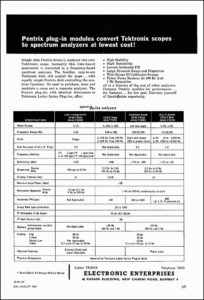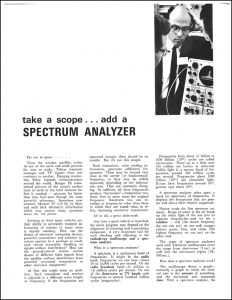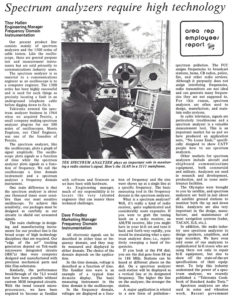The first Tektronix oscilloscopes, comprised of the 511 series, were a resounding success and launched the company. Each oscilloscope in the family was designed for a specific set of market needs and required a new mechanical package. Howard thought there was a better way and first proposed the concept of a plug-in where the mechanical package and supporting circuitry could be common and the plugin could provide the unique characteristics. The 531 oscilloscope was the first plug-in oscilloscope and accepted the soon to be called letter series and 1 series plug-ins.
Pentrix, an electronics company in Brooklyn, NY, developed the L10 spectrum analyzer plug-in for the Tek 530/540 family of oscilloscopes. This photo is of the Pentrix Corporation booth at the 1964 IEEE show.

Tektronix acquired Pentrix in 1964 and the three founders Arnie Frisch, Morris Engelson, and Larry Weiss moved to Beaverton to continue production. The L10 became Tektronix L-10A and then the 1L10. Tektronix Gets Into The Spectrum Analyzer (SA) Business: The Story Behind The Story, Behind The Story, a personal perspective by Morris Engelson on the founding of Pentrix, is on our Employees Story page.
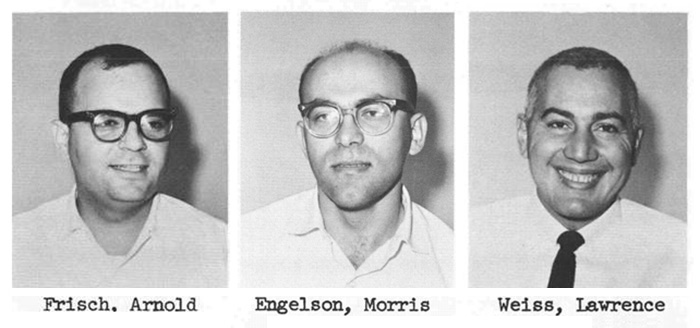
The museum has this Pentrix L-20 SpetrØpulse Analyzer plug-in manufactured by Tektronix.

This extract of a multi-page advertisement of Electronics Limited, a distributor in India, is from the August 1964 Journal of Scientific and Industrial Research. The second page details the line of Pentrix plug-ins, and the L140 and L160 are listed as Spectrum Adapters for some reason. Click on the image to view the PDF of the Pentrix page.
This article on Spectrum Analyzers is from Spring of 1965. Click on the image to read the PDF document.
Tektronix designed the 1L20 and 1L30, and later the 1L5. The first portable spectrum analyzer was the 491 introduced in 1967. Although the 491 required an expert user and had only 40 dB of dynamic range, it moved microwave measurements into the field and many units were sold to those servicing radar systems. The museum has the original prototype for the 491 portable spectrum analyzer.

At some point the development team became Frequency Domain Instruments (FDI). They developed the 1401, a small and moderately easy to use spectrum analyzer. This instrument was the same size and shape as the 323 Sony/Tek oscilloscope which was the display portion. It was announced in 1971 and featured coverage of 0.1 to 500 MHz with a spurious free and about 55 or 60 dB of dynamic range. It was not amplitude calibrated. While it was a great leap forward for the group, it wasn't well accepted. A later version added an amplitude reference signal which allowed to set the gain knob to give a known response. The museum has a 1401/323 spectrum analyzer on display. Both the 1401 and the 323 were battery powered and there was hardware to configure them as a single instrument. This combination was quite popular with cable television companies.
The wire antenna is simply picking up and displaying local FM radio stations. The horizontal spectrum is 500 KHz per division so this display shows the radio stations separated by about 800 KHz. The rightmost "bump" shows the characteristic sidebands for the additional HD portion of the FM broadcast.

Following the 1401, Tektronix started developing plug-in spectrum analyzers for the newly introduced 7000 series oscilloscopes. The first was the 7L12 double wide plug-in with coverage from a few kHz to 1800 MHz introduced in 1972. It featured 75 to 80 dB spurious-free dynamic range, amplitude calibration and a moderately accurate frequency calibration. It featured a 3 MHz max resolution bandwidth good for sweeping fast and looking at the big picture and down to 300 Hz in decade steps. It was a good work-horse general utility unit. The museum has a 7L12 on display in a 7704A mainframe with two timebases, one for horizontal and one for vertical. The 7L12 output is modulating the Z axis for display of live analog television signals. The picture is displayed upside down.

The 7L13 triple-wide plug-in was introduced in 1974. By making the unit wider there was enough space to phase lock the second local oscillator allowing the unit to smoothly sweep a 30 Hz resolution bandwidth. It could measure hum sideband amplitudes on GHz signals. The other major feature of this analyzer was an electromechanical assembly that allowed a single tuning knob to adjust a coarse tune or a fine tune control. The instrument selected which control was to be adjusted based on the span selected by the user.
This October 10, 1975 TekWeek describes spectrum analyzers by Thor Hallen and Dave Friedley. Click on the image to view the PDF.
This 1975 Tektronix Cookbook of Standard Audio Tests describes using a low frequency spectrum analyzer as an alternative test device and procedures that permit rapid and easy to understand testing. Click on the image to view the PDF.
The 7L5 double-wide plug-in was introduced in 1976. It was the first unit to be controlled by logic signals. It was also the first spectrum analyzer to feature phase-lock controlled frequency accuracy. Its coverage was from a few Hz to 5 MHz and also featured a plug-in front-end module so one could choose a variation of impedance and dynamic range configurations. This instrument was also the first to feature digital storage to make it possible to interpret the results of very slow sweeps that a very narrow resolution bandwidth required.
Also at this time the 7L18 program was under way to build Tektronix' first modern microwave spectrum analyzer. This product featured a YIG filter, the first of the Tektronix made microwave components. It was also the first Tektronix instrument to feature microprocessor control using an Intel 4004 and 3 Kbyes of ROM. Key challenges on this project were the design of the microwave components and the control of the highly precision analog electronics which required 1 part in 18,000 to position the preselector. The 7L18 was introduced in 1978 and featured coverage from 1.5 Ghz to 18 GHz, with an 80 dB dynamic range and a resolution band width range of 3 MHz to 30 Hz in decade steps. External waveguide mixers could be used for much higher frequencies. One could easily measure hum sidebands on an 18 GHz signal.
The Navy approached Tektronix wanting a modern version of the 491. Tektronix had the engineering know-how from the 7L18 program and more microwave components. The team developed a modular architecture where several products could be constructed from modules resulting in a larger volume of modules that went into lower volume instruments. There were a number of instruments in this series including the 492 (0 to 18 GHz), the 496 (0 to 1.8 GHz), the 494 (a 492 with the ability to set accurately to frequency) and a number of other instruments including bench top. External waveguide mixers could be used for much higher frequencies. Modules were reused; as one was updated or replaced it was always backward compatible including the firmware.
This May 30, 1980 TekWeek features the introduction of the 492.

This December 7, 1979 TekWeek features the development of the 492. Click on the image to view the PDF.
We also have a video of the 492 and 496 Portable Spectrum Analyzers on our Video Gallery.
This January 1980 issue of Field Application Engineer features Frequency Domain Instruments (FDI). Click on the image to view the PDF.
This August 8, 1981 TekWeek features the last 491 Portable Spectrum Analyzer built.

The museum has a 496 spectrum analyzer introduced in 1982 on display. It is configured with a TR503 tracking generator. The tracking generator is a sweeping signal source at the same frequency as the spectrum analyzer. Its output is going through a bandpass filter seen at the bottom of this photo.

The result is an amplitude display of the characteristics of the bandpass filter with about a 5 MHz bandwidth as seen in this photo.

Two developments followed introducing first a low cost family consisting of the 2710 and the highly successful 2712 spectrum analyzers. This May 22, 1987 TekWeek article describes the 2710 development effort and highlights Bill Benedict, the 2710 champion. Click on the image to view the PDF.
The 2782 spectrum analyzer, introduced in 1990, moved virtually every performance characteristic far ahead of the competition at that time. Frequency coverage is 100 Hz to 32 GHz and up to 325 GHz with an external waveguide mixer. The display also features color and initially sold for $65,000. This June 16th, 1989 TekWeek has two articles on the 2782 spectrum analyzer.


The museum has a 2782 on display and it is likewise configured with a simple antenna to display local FM stations in the area.

During the development of the 2782 another team called NPU was formed by ex-FDI engineering manager Steve Morton to develop a real time spectrum analyzer (RTSA), the 3052 introduced in 1988.
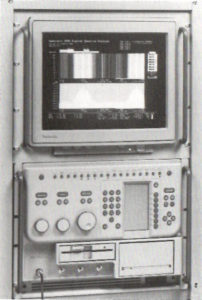
The 3052 was based on an input data windowing system invented by Tran Thong and a set of application specific FFT ICs developed at Honeywell. The base unit featured coverage to only a few MHZ but was augmented by adapting spectrum analyzer concepts to give the ability to tune the unit to any frequency up to several GHz. The product was primarily sold to to military and other government surveillance customers and this group was eventually moved into a wholly owned subsidiary called Tektronix Federal Systems to better support the customer. This August 5, 1988 TekWeek features the new digital 3052. Click on the image to view the PDF.
We have a video of the 3052 Digital Spectrum Analyzer 1988 on our Video Gallery.
The follow-on product was the 3054 which had much improved processing power and doubled the analysis bandwidth to 4 MHz.
Sony/Tek was in the process of trying to market a real time spectrum analyzers to the Japanese Ministry of Posts and Telecommunications which was interested in finding illegally enhanced power transmitters causing electromagnetic interference problems with authorized communications. The 3054 could not be exported so Sony/Tek designed a new line of real time spectrum analyzers. Sony/Tektronix used off-the-shelf digital integrated circuits to perform a very fast and more cost-effective frequency spectrum calculation employing Fast Fourier Transform techniques. The 3055 was introduced in 1995 and had the same performance with the 3052 but without a front panel which required a PC for control.

This 1996 Tekweek article describes the Ministry of Post & Telegraph contract utilizing the 3055.

Sony/Tek developed and introduced these follow-on spectrum analyzers:
Model Bandwidth Range Year
3066 5 MHz 3 GHz 1996
3056 5 MHz 3 GHz 1997
3026 2 MHz 3 GHz 1998
WCA330 30 MHz 3 GHz 1998
WCA380 30 MHz 8 GHz 2000
WCA230 15 MHz 3 GHz 2001
WCA280 15 MHz 8 GHz 2001
RSA230 10 MHz 3 GHz 2001
RSA280 10 MHz 8 GHz 2001
WCA230A 15 MHz 3 GHz 2003
WCA280A 15 MHz 8 GHz 2003
RSA2203A 10 MHz 3 GHz 2003
RSA2208A 10 MHz 8 GHz 2003
RSA3303A 15 MHz 3 GHz 2003
RSA3308A 15 MHz 8 GHz 2003
RSA3408A 36 MHz 8 GHz 2004
More information on Sony/Tek may be found on our Sony/Tektronix and on our Sony/Tektronix Products pages.

